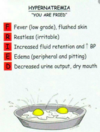9 - Plasma Osmolality Flashcards
(38 cards)
What is normal osmolarity in the body?
- 280-310 mOsm/kg
- 290 in interstitial fluid
- 291 in blood plasma due to plasma proteins ==> oncotic pressure
How do you alter plasma osmolarity?

What is urine osmolarity?
- Varies from 50-1200 mOsm/kg
- Normal is 500-700
If there is an osmolarity change in the blood what does this mean the body has an issue with?
Water balance not Na reabsorption
What nephrons are responsible for concentrating urine and how do they do this?
- Juxta medullary long LOH generates gradient
- Vasa recta from efferent arteriole running paralell with Loop of Henle and blood running countercurrent maintains gradient
- Counter current multiplier system

What are the three processes involved in the counter-current multiplier system?
- Active secretion of NaCl
- Urea recycling
- Vasa recta maintaining gradient
What is the difference in transport between the ascending and descending limb?

When may you see this concentration gradient between the loop of henle and the medullary interstitium and what are the consequences of this?

- Newly transplanted kidney or long term loop diuretics as they block NKCC2 so no gradient can be established
- Lots of dilute urine made
How can urea be used to help reabsorb more water?
- Uptake in the PCT, 50% filtered is taken back
- Under ADH influence, urea reabsorbed from medullary CD
- Urea increases osmotic gradient in the interstitium so more water reabsorbed
- Urea then just taken back up into loop and cycles round

How do we supply blood to the medulla of the kidney without washing away the osmotic gradient needed to reabsorb water?
- Vasa recta with very slow flow
- No active transport just passive absorption through endothelial cells
- Flow opposite direction to tubular fluid flow
- Equilibriates at each level

How is a change in plasma osmolality detected in the body and what action is taken to resore the normal osmolality?
- Osmoreceptors in hypothalamus in OVLT
- Cells in supraoptic nucleus containing baroreceptors sit close to OVLT so if low pressure means low volume and means high osmolarity so ADH secreted

What is the plasma osmolarity feedback loop?
Always a little bit of ADH, never 0

How does the effectiveness of ADH change with changes in plasma volume?
Changes in B.P (plasma volume) have an effect on response to changes in osmolarity

What happens once you have corrected a high plasma osmolality by taking a large drink?

What is diabetes insipidus and how can it cause issues with plasma osmolarity?

What is SIADH and how can it cause issues with plasma osmolarity?

If you had a low plasma osmolarity what might you crave?
SALT
What will happen to the osmolality of urine when plasma osmolality increases/decreases?

What effect does ADH have on the receptors in the collecting duct?
- Always AQP on basolateral membrane but not apical
- When ADH present, AQP from vesicles are added to apical membrane

How may someone with hyponatraemia present?
- Can be confused, lethargic, muscle paralysis, blurred vision, muscle cramps (google quiz)
- Serum conc lower than 135mmol

How may someone with hypernatraemia present?

If someone presented with the following blood parameters what may you think the diagnosis is and how may you treat it?
- Serum osmolality 259 (decreased)
- Urine osmolality 522 (decreased)
- Urine Na 81 (increased)
- SIADH, kidneys are uneccessarily diluting urine
- Fluid restrict
- Wean off any meds like valproate that cause inappropriate ADH release
What are some causes of hyponatraemia?
- Severe diarrhoea and vomiting (losing water too so no osmolality change)
- Diuretics/Renal failure
- Peritonitis
- Burns
- Na/Water imbalance
- Anything that changes ADH secretion

What are some causes of hypernatraemia?












